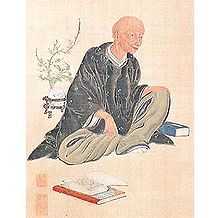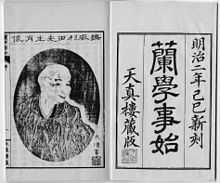Sugita Genpaku




Sugita Genpaku (杉田 玄白, 20 October 1733 – 1 June 1817) was a Japanese scholar known for his translation of Kaitai Shinsho (New Book of Anatomy).
Besides Kaitai Shinsho, he also authored Rangaku Kotohajime (Beginning of Dutch Studies).
Sugita assembled a team of Japanese translators and doctors to translate a Dutch book of anatomy: Kulmus' "Ontleedkundige Tafelen". He did so because he found out, after observing the dissection of a human corpse, that the western drawings of human organs were much more accurate than the ones in his Chinese handbooks. They tried to make a Japanese translation. At a rate of one page a week/month, the work was published in 1774. As an example of how difficult this work was, the collaborators had to study and discuss for several days before they realised that "neus" (nose) in Dutch, being a bulb on the front, meant hana (鼻) in Japanese.
External links
- Kaitai shinsho. Selected pages scanned from the original work. Historical Anatomies on the Web. US National Library of Medicine.
- Online text of Genpaku's Rangaku Kotohajime (Dawn of Western Science in Japan)
|